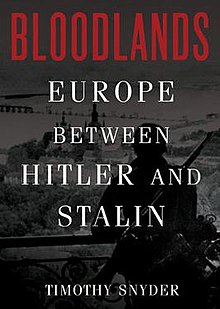
Back بلاد الدم: أوروبا بين هتلر وستالين Arabic Krvavé země Czech Bloodlands Greek Tierras de sangre (libro) Spanish Terres de sang : L'Europe entre Hitler et Staline French Skrwawione ziemie Polish Кровавые земли Russian Криваві землі Ukrainian Bloodlands, Europe Between Hitler and Stalin Vietnamese
 | |
| Author | Timothy Snyder |
|---|---|
| Language | English |
| Subject | Mass murders before and during World War II |
| Genre | History |
| Publisher | Basic Books |
Publication date | 28 October 2010 |
| Pages | 544 |
| ISBN | 978-0-465-00239-9 |
Bloodlands: Europe Between Hitler and Stalin is a 2010 book by Yale historian Timothy Snyder. It is about mass murders committed before and during World War II in territories controlled by Nazi Germany and the Soviet Union.
In this book, Snyder examines the political, cultural, and ideological context tied to a specific region of Central and Eastern Europe, where Joseph Stalin's Soviet Union and Adolf Hitler's Nazi Germany committed mass murders of an estimated 14 million noncombatants between 1933 and 1945, the majority outside the death camps of the Holocaust. Snyder's thesis delineates the "bloodlands" as a region that now comprises Poland, Belarus, Ukraine, the Baltic states (Estonia, Latvia, and Lithuania), northeastern Romania, and the westernmost fringes of Russia; in this region, Stalin and Hitler's regimes, despite their conflicting goals, interacted to increase suffering and bloodshed beyond what each regime would have inflicted independently.[1]
Snyder draws similarities between the two totalitarian regimes and the enabling interactions that reinforced the destruction and suffering that they inflicted upon noncombatants.[1] According to Anne Applebaum, "Snyder's book has a lot of information that people who know these subjects know very well. But what it does that is different and wholly original is show the ways that Hitler and Stalin echoed one another, at times working together and other times fighting one another. The way in which they egged each other on, acting as two facets of what was really the same phenomenon."[2]
According to Snyder, "the Germans deliberately killed about 11 million noncombatants, a figure that rises to more than 12 million if foreseeable deaths from deportation, hunger, and sentences in concentration camps are included. For the Soviets during the Stalin period, the analogous figures are approximately 6 million and 9 million."[3]
The book was awarded numerous prizes, including the 2013 Hannah Arendt Prize for Political Thought, and stirred up a great deal of debate among historians. Reviews ranged from highly critical to "rapturous".[4][5]
- ^ a b Cite error: The named reference
Anne Applebaumwas invoked but never defined (see the help page). - ^ Cite error: The named reference
Globe reviewwas invoked but never defined (see the help page). - ^ Snyder, Timothy (10 March 2011). "Hitler vs. Stalin: Who Killed More?" The New York Review of Books. Retrieved 25 December 2020.
- ^ Sémelin, Jacques (14 February 2013). "Timothy Snyder and his Critics". La Vie des Idées. Translated by Kate McNaughton. Archived from the original on 9 January 2021. Retrieved 28 November 2021 – via Books & Ideas.
- ^ Mikanowski, Jacob (12 April 2019). "The Bleak Prophecy of Timothy Snyder". The Chronicle of Higher Education. Archived from the original on 9 January 2021. Retrieved 16 April 2019.
© MMXXIII Rich X Search. We shall prevail. All rights reserved. Rich X Search